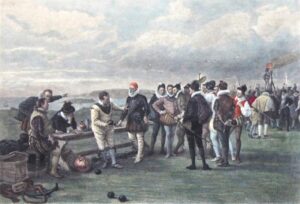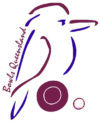Bowls is a game of great antiquity.

A famous picture of Sir Frances Drake playing Sir Walter Raleigh before fighting the Spanish Armada in 1588
We know from studies of ancient Egypt that a bowls-like game was played in the land of the Pharaohs as far back as 7,200 BC.
This has been stated and verified by Egyptologists in their studies of ancient ‘Books of the Dead’, of which volumes were buried with mummified bodies in their sarcophagus.
Naturally the game spread around the Mediterranean coast and a form of the game is still played in Italy to this day, where it is known as ‘bocce’.
This is played with stone or metal balls that are thrown rather than bowled.
In France and Spain it is played with wooden or stone balls and is called ‘boule’ or ‘petanque’.
It was introduced to Great Britain with the Norman Conquest, where its name loosely translated as ‘throwing the stone’.
It was generally played on a flat, level piece of well grassed sward, wherever it could be found either in the castle courtyard or by the village inn.
The sport became popular with all classes, but this popularity caused problems, with Edward III banning the sport in 1361 because it was interfering with compulsory archery practice.
In 1374 the Marquis of Winchester used a spherical wooden balustrade ornament in place of a stone ball and so the wooden bowl was born.
In 1511, Henry VIII took a leaf from Edward’s laws and, for the same reason, interference with archery training, banned ‘bowles and bowlynge’.
This was the first ever official record of this sport.

Ancient Egyptians played a bowls-like game as far back as 7200 BC, which spread across the Mediterranean, evolving into Bocce in Italy, Petanque in France and Bowles in Great Britain.

The gentry were exempt from the ban and all commoners could play bowls on the green of the local gentry provided it was a holiday or a member of his family was present.
Queen Ann Boleyn and her daughter, Queen Elizabeth I, were both very keen bowlers. Anne, in particular, often wagered huge sums on the result of one shot and was consequently short in her royal purse when she settled her bets. A bet of $5,000 was commonplace.

William Shakespeare knew and understood thoroughly the game of bowls. In his plays we find reference to ‘rubs’, ‘upcasts’, ‘kissing the white’, ‘onward ever onward thus a bowl should roll’ and so on.
King James I laid down a green at Hampton Court Palace in 1605. It cost £49.11s.7d…about $4911.70 and workers were paid 15c a day.
In the reign of Queen Victoria, all prohibitions on the sport were lifted and many greens were laid, both public (pay as you play… similar to squash courts) and private or club.
It became very popular with all classes in Victorian and Edwardian times and to be a bowler was seen to be a person of upright moral standing in the community and a pillar of the establishment.
In the reign of King George VI a green was laid at both Buckingham Palace and Windsor Castle and the Royal Household Bowling Club was formed.
Several members of the Royal family are keen and enthusiastic bowlers.
Queen Elizabeth II in 1959 conferred the title ‘Royal’ upon the Queensland Bowling Association, and so it became the RQBA.
In 1924, as a result of international bickering between the UK and Australia, the International Bowling Board was founded.
It was very one-eyed at first but now, with the presidency rotating in turn between members countries, it has settled down and has finally become the world controlling body.
The Australian Bowls Council (now Bowls Australia) is a charter member of the IBB (now called the World Bowling Board).
